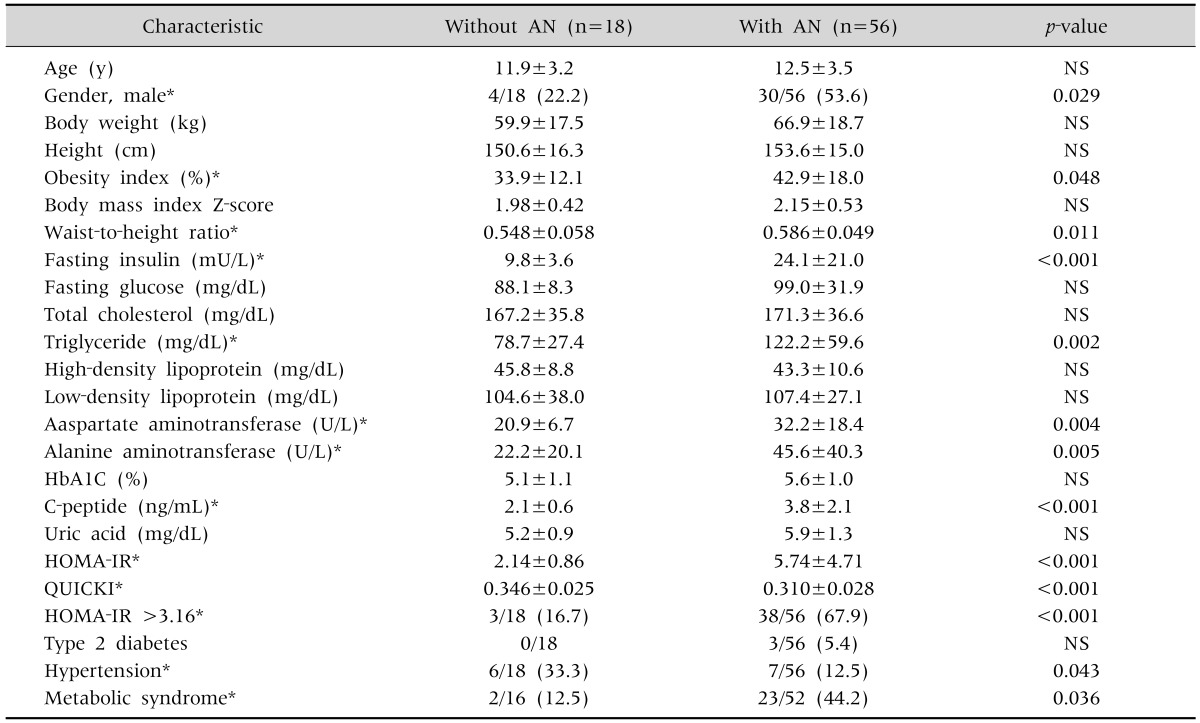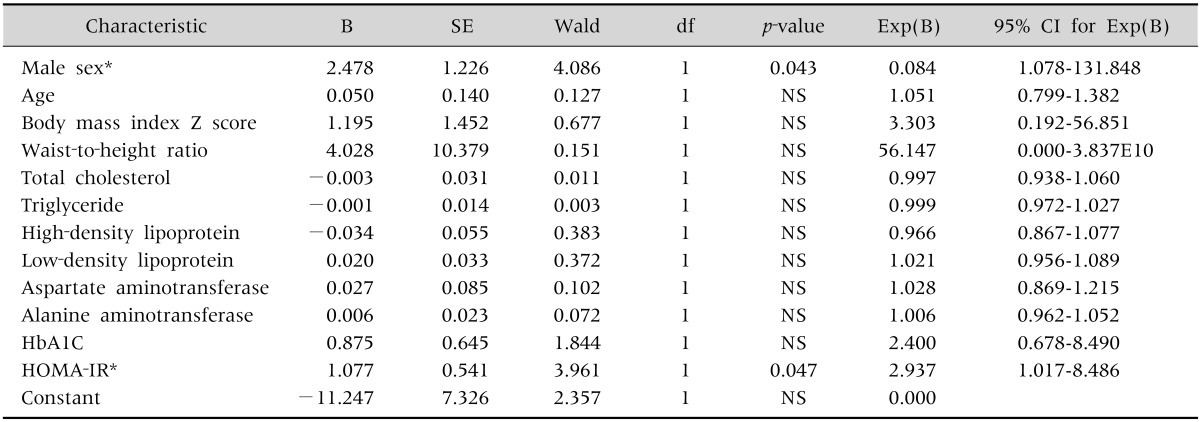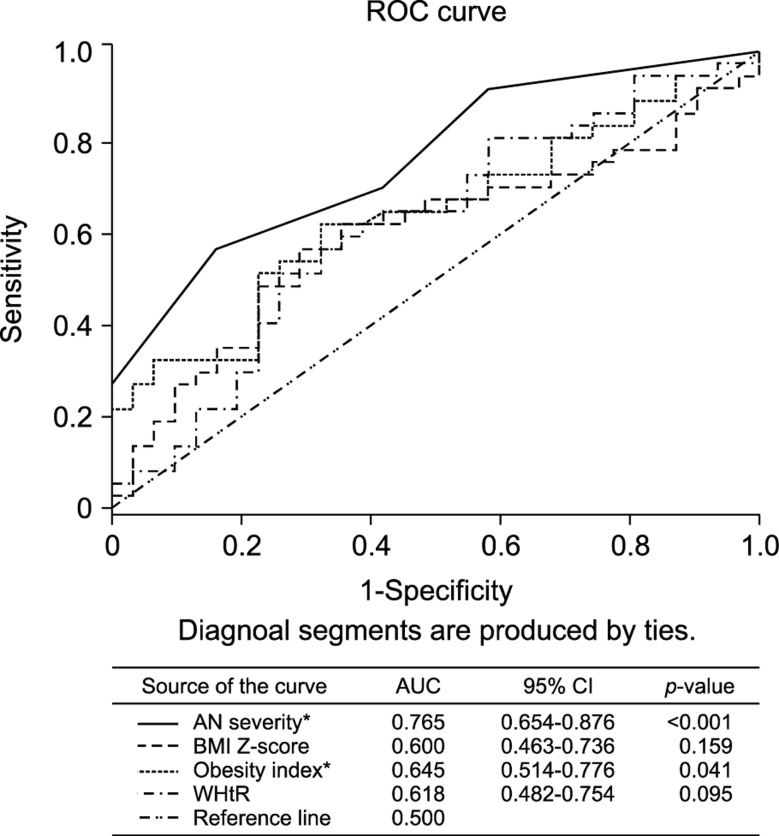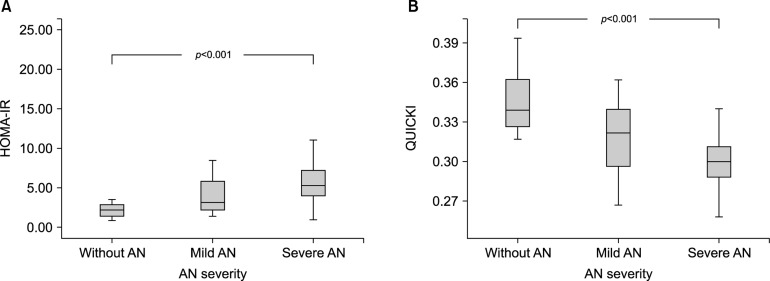Abstract
Purpose
This study aimed to evaluate the utility of acanthosis nigricans (AN) severity as an index for predicting insulin resistance in obese children.
Methods
The subjects comprised 74 obese pediatric patients who attended the Department of Pediatrics at Chosun University Hospital between January 2013 and March 2016. Waist circumference; body mass index; blood pressure; fasting glucose and fasting insulin levels; lipid profile; aspartate transaminase, alanine transaminase, glycated hemoglobin, C-peptide, and uric acid levels; and homeostatic model assessment insulin resistance (HOMA-IR) and quantitative insulin check sensitivity index (QUICKI) scores were compared between subjects with AN and those without AN. Receiver operating characteristic curves were used to investigate the utility of the AN score in predicting insulin resistance. HOMA-IR and QUICKI were compared according to AN severity.
Results
The With AN group had higher fasting insulin levels (24.1±21.0 mU/L vs. 9.8±3.6 mU/L, p<0.001) and HOMA-IR score (5.74±4.71 vs. 2.14±0.86, p<0.001) than the Without AN group. The AN score used to predict insulin resistance was 3 points or more (sensitivity 56.8%, specificity 83.9%). HOMA-IR scores increased with AN severity, from the Without AN group (mean, 2.15; 95% confidence interval [CI], 1.72-2.57) to the Mild AN (mean, 4.15; 95% CI, 3.04-5.25) and Severe AN groups (mean, 7.22; 95% CI, 5.08-9.35; p<0.001).
Conclusion
Insulin resistance worsens with increasing AN severity, and patients with Severe AN (AN score ≥3) are at increased risk of insulin resistance.
Keywords: Acanthosis nigricans, Insulin resistance, Hyperinsulinism, Pediatric obesity
INTRODUCTION
With the adoption of Western dietary habits and a general decline in physical activity, the prevalence of childhood obesity in South Korea is increasing gradually. The prevalence of overweight and obese children has increased to more than 1.5-fold between 1998 and 2007, from 13.0% to 19.0% and 5.8% to 9.7% respectively [1]. As such, there is an urgent need for preventive education and the establishment of appropriate control measures.
Moderate or severe childhood obesity can result in metabolic complications such as insulin resistance, glucose intolerance, type 2 diabetes, and nonalcoholic fatty liver disease. In particular, insulin resistance is the most important mechanism underlying metabolic abnormalities in obesity, and often leads to other metabolic complications and cardiovascular disease [2]. Insulin resistance causes dyslipidemia, glucose intolerance, cardiovascular disease, and type 2 diabetes. This phenomenon is known as "metabolic syndrome" [3].
Acanthosis nigricans (AN) is a relatively common skin lesion observed in obese patients. AN is characterized by thickened and rough skin, irregular wrinkles, and brown pigmentation. It can develop in various parts of the body, including the neck, armpits, knees, elbows, and the curved surface of the inguinal region [4]. There is close correlation between AN and insulin resistance [5]. Insulin resistance increases with increased body fat, and may appear months to years before the onset of type 2 diabetes. It plays a central role in metabolic syndrome, and is an independent factor affecting lipid metabolism and cardiovascular disease in adults [6]. Many studies have investigated the utility of AN as a screening test for insulin resistance [4]. However, there were few studies have attempted a quantitative comparison of insulin resistance in relation to AN [7,8].
The present study quantified AN severity in obese children, with the aim of examining its utility as an index for predicting insulin resistance.
MATERIALS AND METHODS
Study subjects
Subjects comprised 74 children under 19 years of age who attended the Department of Pediatrics at Chosun University Hospital between January 2013 and March 2016, and who had an obesity index ([actual body weight–standard body weight]/standard body weight×100) of 20% or greater. The standard body weight was taken as the median body weight by height used in the 2007 Korean National Growth Chart [9], published by the Korea Centers for Disease Control and Prevention, and the Korean Journal of Pediatrics.
Physical measurements
Body mass index (BMI=body weight [kg]/height [m2]) was calculated from each subject's height and weight. Z-scores were obtained by age and gender using data from the 2007 Korean National Growth Chart [9]. Waist circumference (cm) was measured at the highest point of the iliac crest, and was used to calculate waist-to-height ratio (WtHR=waist circumference [cm]/height [cm]). Blood pressure (BP) was measured using an oscillometric sphygmomanometer after at least 10 minutes of rest. The width of the cuff used had to cover approximately 2/3 of the upper arm length. Hypertension was defined as systolic and/or diastolic BP over the 95th percentile, based on the 2007 Korean National Growth Chart [9].
Blood serum tests
Subjects fasted for 9-12 hours (from 10 PM to 7-10 AM) prior to blood collection for the laboratory tests. Fasting glucose, fasting insulin, total cholesterol, triglyceride, high-density lipoprotein (HDL), low-density lipoprotein (LDL), aspartate aminotransferase (AST), alanine aminotransferase (ALT), glycated hemoglobin (HbA1C), C-peptide, and uric acid levels were measured.
Homeostatic model assessment insulin resistance (HOMA-IR) was used as an index of insulin resistance, and was calculated as follows: HOMA-IR=fasting insulin (µU/mL)×fasting glucose (mg/dL)/405. A HOMA-IR of 3.16 or higher was interpreted as insulin resistance [10]. The quantitative insulin sensitivity check index (QUICKI) was used as an index of insulin sensitivity, and was calculated as follows: QUICKI=1/{log[fasting insulin (µU/mL)]+log[fasting glucose (mg/dL)]}.
Acanthosis nigricans
AN was clinically diagnosed when thick, rough, irregular wrinkles and brown pigmentation in the skin around the neck and armpits were observed. AN severity was evaluated based on the neck severity scale (Table 1) designed by Burke et al. [11], which had shown relatively good reproducibility in previous studies.
Table 1. The Neck Severity of Acanthosis Nigricans.
Adapted from Burke et al. (Diabetes Care 1999;22:1655-9) [11].
Metabolic complications
Type 2 diabetes, which may present with symptoms of polyuria, polydipsia, polyphagia, and weight loss, was diagnosed when fasting glucose was 110 mg/dL or higher, 2-hour glucose was 200 mg/dL or higher in an oral glucose tolerance test, or when HbA1C was 6.5% or higher [12]. No established diagnostic criteria for metabolic syndrome in pediatric patients exist; as such, we used a modified version of the diagnostic criteria proposed by the Third Report of the National Cholesterol Education Program Expert Panel on Detection, Evaluation, and Treatment of High Blood Cholesterol in Adults (Adult Treatment Panel III) [13]. Metabolic syndrome was diagnosed when 3 of the following 5 indices exceeded the cut-off value specific for the patient's gender, age, and height: 1) waist circumference ≥90th percentile, 2) triglycerides >110 mg/dL, 3) HDL <40 mg/dL, 4) fasting glucose >110 mg/dL, and 5) BP: systolic pressure or diastolic pressure ≥90th percentile.
Statistical processing
All statistical values were presented as mean±standard deviation. For continuous variables, the means of the two independent groups were compared using the Student's t-test and Mann-Whitney non-parametric test. For categorical variables, the frequencies and percentages were compared using the Fisher exact test. A binary logistic regression model was used to investigate risk factors related to the presence of AN, and receiver operating characteristic (ROC) curves were used to find a test to predict insulin resistance with high sensitivity and specificity. Comparison of means according to AN severity was performed using the one-way analysis of variance (ANOVA) and Kruskal-Wallis test. All analyses were performed with PASW Statistics ver. 18.0 (IBM Co., Armonk, NY, USA). Only p-values of less than 0.05 were considered to be statistically significant.
Ethics statement
This study was approved by the insititutional review board (IRB) at Chosun University Hospital (IRB no. CHOSUN 2016-04-011).
RESULTS
Subject characteristics
The mean age of the 74 subjects was 12.3±3.4 years. Thirty-four of the subjects were male and 40 were female. The mean obesity index was 40.7±71.2%, and the BMI Z-score was 2.11±0.51. AN was observed in 56 subjects (75.7%). Three subjects (4.1%) were newly diagnosed with type 2 diabetes. Hypertension was observed in 13 patients (17.6%), and metabolic syndrome was diagnosed in 25 (36.8%) (Table 2).
Table 2. Clinical Characteristics of the Study Subjects.
Values are presented as mean±standard deviation or number (%).
Clinical characteristics and biochemical results according to acanthosis nigricans status
There were no statistically significant differences between the Without AN and the With AN groups with regard to age, weight, height, or BMI Z-score. There were significantly more males in the With AN group compared to the Without AN group (53.6% vs. 22.2%, p=0.029). Obesity index was higher in the With AN group than the Without AN group (p=0.048), as was WtHR (p=0.011). Fasting glucose, total cholesterol, HDL, LDL, HbA1C, and uric acid levels were not significantly different between the two groups. However, fasting insulin (9.8±3.6 mU/L vs. 24.1±21.0 mU/L, p<0.001), triglyceride (78.7±27.4 mg/dL vs. 122.2±59.6 mg/dL, p=0.002), AST (20.9±6.7 U/L vs. 32.2±18.4 U/L, p=0.004), ALT (22.2±20.1 U/L vs. 45.6±40.3 U/L, p=0.005), and C-peptide (2.1±0.6 ng/mL vs. 3.8±2.1 ng/mL, p<0.001) levels were higher in the With AN group than the Without AN group. HOMA-IR was significantly higher in the With AN group (2.14±0.86 vs. 5.74±4.71, p<0.001), and QUICKI was significantly lower (0.346±0.025 vs. 0.310±0.028, p<0.001) in this group. In addition, the With AN group had a significantly higher rate of insulin resistance (p<0.001), hypertension (p=0.043), and metabolic syndrome (p=0.036; Table 3).
Table 3. Clinical Characteristics and Biochemical Parameters according to the Absence or Presence of Acanthosis Nigricans.
Values are presented as mean±standard deviation or number (%).
AN: acanthosis nigricans, HbA1C: glycated hemoglobin, HOMA-IR: homeostatic model assessment insulin resistance, QUICKI: quantitative insulin sensitivity check index, NS: not significant.
*p<0.05.
Factors related to the development of acanthosis nigricans
In order to evaluate risk factors for AN in obese patients, a binary logistic regression analysis was performed on gender, age, BMI Z-score, WtHR, total cholesterol, triglyceride, HDL, LDL, AST, ALT, HbA1C, and HOMA-IR. The results showed that the male gender and a higher HOMA-IR score increased the risk of developing AN (Table 4).
Table 4. The Interaction between Acanthosis Nigricans and Variables Using the Binary Logistic Regression Model.
B: values for the logistic regression equation, SE: standard error, df: degrees of freedom, EXP(B): exponentiation of the B coefficient, CI: confidence interval, HbA1C: glycated hemoglobin, HOMA-IR: homeostatic model assessment insulin resistance, NS: not significant.
*p<0.05.
Acanthosis nigricans severity in the prediction of insulin resistance: cut-off value and comparison with other indices
ROC curves were used to compare the predictive power of AN severity, BMI Z-score, obesity index, and WtHR in the diagnosis of insulin resistance (HOMA-IR >3.16). Of these variables, only AN severity (p<0.001) and obesity index (p=0.041) showed a predictive power of at least 0.5 within the 95% confidence interval (CI). The area under the curve (AUC) for AN was 0.765, which was higher than the AUC of 0.645 for obesity index (Fig. 1). The ROC curve was used to find a cut-off value of AN severity that was suitably sensitive and specific. At an AN severity of 3 or greater, the sensitivity for predicting insulin resistance was 56.8%, and the specificity was 83.9%, providing relatively high specificity.
Fig. 1. Receiver operating characteristic curves for prediction of insulin resistance. ROC: receiver operating characteristic, AUC: area under curve, CI: confidence interval, AN: acanthosis nigricans, BMI: body mass index, WHtR: waist-to-height ratio.
*p<0.05.
The relationship between insulin resistance and insulin sensitivity according to acanthosis nigricans severity
Subjects were divided into three groups: Without AN, Mild AN (AN severity score of 1-2), and Severe AN (AN severity score of 3-4). HOMA-IR and QUICKI were examined in these groups. HOMA-IR, which represents insulin resistance, increased with increasing AN severity (Without AN group: mean, 2.15; 95% CI, 1.72-2.57; Mild AN group: mean, 4.15; 95% CI, 3.04-5.25; Severe AN group: mean, 7.22; 95% CI, 5.08-9.35; p<0.001) (Fig. 2A). QUICKI, which drepresents insulin sensitivity, decreased with increasing AN severity (Without AN group: mean, 0.346; 95% CI, 0.334-0.359; Mild AN group: mean 0.319; 95% CI, 0.310-0.329; Severe AN group: mean 0.300; 95% CI, 0.289-0.311; p<0.001) (Fig. 2B).
Fig. 2. Comparison of acanthosis nigricans (AN) severity in terms of homeostatic model assessment insulin resistance (HOMA-IR) and quantitative insulin sensitivity check index (QUICKI). The p-value from (A) one-way ANOVA and (B) Kruskal-Wallis test is given. AN: acanthosis nigricans.
DISCUSSION
AN is a dermatological disorder characterized by symmetrical plaques with hyperpigmentation and hyperkeratosis. It is commonly seen in obese patients. It is usually observed on the posterior neck, axilla, and groin, but may also be observed on the elbows, knuckles, and knees [14]. AN is known to occur when the concentration of insulin-like growth factor receptors in the skin is too low relative to the amount of insulin present, causing accumulation of insulin in the skin, proliferation of epidermal cells, and thickening of keratocytes [15]. AN is associated with obesity and endocrine diseases caused by severe insulin resistance, and may rarely be seen in patients with genetic diseases or malignant tumors [16,17].
The development of insulin resistance in obese patients can cause several metabolic abnormalities to occur simultaneously. This phenomenon was first named "syndrome X" by Reaven [18]. Since then, various studies have demonstrated that insulin resistance can cause dyslipidemia, fatty liver disease, hypertension, and type 2 diabetes, and this phenomenon is now more commonly referred to as "metabolic syndrome" [3]. Insulin sensitivity typically declines during puberty, which results in physiological insulin resistance [19]. However, when obesity causes insulin resistance to develop before obesity, this pathological condition can become further aggravated in adulthood. Therefore, when insulin resistance is detected in obese children, it is important that appropriate treatment should be commence dearly.
Kahn et al. [5] first suggested an association between AN and insulin resistance in obese children in 1976. Since then, many studies have been conducted with the aim of utilizing AN as an indicator for insulin resistance [4,11,20]. However, due to the lack of unified guidelines for classifying AN severity, these attempts have met with some difficulty. Stuart et al. [21] attempted to develop a quantitative scale for AN by observing its presentation in the neck, axilla, elbow, and groin, and then assigning a score according to the number of body parts affected. However, since they did not suggest criteria for measuring differences in the extent of AN in any given area, the accuracy of any assessment was limited. Following this, Burke et al. [11] conducted a study in adult Mexican American patients, in which they evaluated AN in 5 areas: the neck, axilla, knuckles, elbow, and knee. Of these, neck severity showed a relatively small inter-examiner error and good reproducibility. In addition, increasing neck severity of AN was found to be associated with high fasting insulin levels and BMI. Several studies have used this scale to compare AN severity quantitatively quantitatively [22,23]; however, there remains a dearth of such research in pediatric patients.
Using the scale proposed by Burke et al. [11], this study investigated the utility of AN severity in the neck as a predictor of insulin resistance in obese Korean children. We verified that increased AN severity was associated with an increase in insulin resistance and a decrease in insulin sensitivity. In addition, we found that BMI did not have a separate effect on AN, and that insulin resistance independently increased the risk of AN. Many studies have already demonstrated the key role that insulin resistance plays in metabolic syndrome, and these studies recommended the use of AN as a tool for the early detection of insulin resistance and metabolic syndrome [24,25]. We have shown that patients with severe AN, with a neck severity score of 3 or higher, have an increased risk of insulin resistance, and as such, require thorough examination and treatment.
This study was conducted on obese patients with an obesity index of 20% or higher who visited Chosun University Hospital. The prevalence of AN was higher in male patients than in female patients. This may reflect selection bias, in which only more severe obese male patients were likely to be included in the subject group. Other limitations include a relatively small sample size (74 subjects); use of subjective criteria for evaluating AN severity; and the lack of follow-up examinations, which made it impossible to observe the rate of subsequent complications. Therefore, there is a need for randomized controlled trials to investigate the utility of AN as an index for the early detection of metabolic syndrome risk. In addition, the index will need to be made more objective, by perhaps using an official index and comparing the assessments of 2 or more examiners. Follow-up examinations of pediatric patients with AN will also be required to investigate the risk of developing metabolic syndrome.
ACKNOWLEDGEMENTS
This study was supported by research funds from Chosun University, 2013.
References
- 1.Seo JW. Obesity in children and adolescents. Korean J Pediatr. 2009;52:1311–1320. [Google Scholar]
- 2.Weiss R, Kaufman FR. Metabolic complications of childhood obesity: identifying and mitigating the risk. Diabetes Care. 2008;31(Suppl 2):S310–S316. doi: 10.2337/dc08-s273. [DOI] [PubMed] [Google Scholar]
- 3.Hong YM. Metabolic syndrome in children and adolescents. Korean J Pediatr. 2009;52:737–744. [Google Scholar]
- 4.Chueh HW, Cho GR, Yoo JH. Clinical significance of acanthosis nigricans in children and adolescents with obesity induced metabolic complications. Korean J Pediatr. 2007;50:987–994. [Google Scholar]
- 5.Kahn CR, Flier JS, Bar RS, Archer JA, Gorden P, Martin MM, et al. The syndromes of insulin resistance and acanthosis nigricans. Insulin-receptor disorders in man. N Engl J Med. 1976;294:739–745. doi: 10.1056/NEJM197604012941401. [DOI] [PubMed] [Google Scholar]
- 6.Dietz WH. Overweight in childhood and adolescence. N Engl J Med. 2004;350:855–857. doi: 10.1056/NEJMp048008. [DOI] [PubMed] [Google Scholar]
- 7.Slyper AH, Kashmer L, Huang WM, Re'em Y. Acanthosis nigricans, vitamin D, and insulin resistance in obese children and adolescents. J Pediatr Endocrinol Metab. 2014;27:1107–1111. doi: 10.1515/jpem-2013-0465. [DOI] [PubMed] [Google Scholar]
- 8.Patidar PP, Ramachandra P, Philip R, Saran S, Agarwal P, Gutch M, et al. Correlation of acanthosis nigricans with insulin resistance, anthropometric, and other metabolic parameters in diabetic Indians. Indian J Endocrinol Metab. 2012;16:S436–S437. doi: 10.4103/2230-8210.104122. [DOI] [PMC free article] [PubMed] [Google Scholar]
- 9.Centers for Disease Control and Prevention. 2007 Korean National Growth Charts [Internet] Osong: 2008. [[cited 2008 Aug 21]]. Available from: http://cdc.go.kr/CDC/notice/CdcKrInfo0201.jsp?menuIds=HOME001-MNU1154-MNU0005-MNU1889&cid=1235. [Google Scholar]
- 10.Keskin M, Kurtoglu S, Kendirci M, Atabek ME, Yazici C. Homeostasis model assessment is more reliable than the fasting glucose/insulin ratio and quantitative insulin sensitivity check index for assessing insulin resistance among obese children and adolescents. Pediatrics. 2005;115:e500–e503. doi: 10.1542/peds.2004-1921. [DOI] [PubMed] [Google Scholar]
- 11.Burke JP, Hale DE, Hazuda HP, Stern MP. A quantitative scale of acanthosis nigricans. Diabetes Care. 1999;22:1655–1659. doi: 10.2337/diacare.22.10.1655. [DOI] [PubMed] [Google Scholar]
- 12.American Diabetes Association. Diagnosis and classification of diabetes mellitus. Diabetes Care. 2014;37(Suppl 1):S81–S90. doi: 10.2337/dc14-S081. [DOI] [PubMed] [Google Scholar]
- 13.National Cholesterol Education Program (NCEP) Expert Panel on Detection, Evaluation, and Treatment of High Blood Cholesterol in Adults (Adult Treatment Panel III) Third report of the National Cholesterol Education Program (NCEP) expert panel on detection, evaluation, and treatment of high blood cholesterol in adults (Adult Treatment Panel III) final report. Circulation. 2002;106:3143–3421. [PubMed] [Google Scholar]
- 14.Yosipovitch G, DeVore A, Dawn A. Obesity and the skin: skin physiology and skin manifestations of obesity. J Am Acad Dermatol. 2007;56:901–916. doi: 10.1016/j.jaad.2006.12.004. [DOI] [PubMed] [Google Scholar]
- 15.Hermanns-Lê T, Scheen A, Piérard GE. Acanthosis nigricans associated with insulin resistance: pathophysiology and management. Am J Clin Dermatol. 2004;5:199–203. doi: 10.2165/00128071-200405030-00008. [DOI] [PubMed] [Google Scholar]
- 16.Dunaif A, Green G, Phelps RG, Lebwohl M, Futterweit W, Lewy L. Acanthosis nigricans, insulin action, and hyperandrogenism: clinical, histological, and biochemical findings. J Clin Endocrinol Metab. 1991;73:590–595. doi: 10.1210/jcem-73-3-590. [DOI] [PubMed] [Google Scholar]
- 17.Schwartz RA. Acanthosis nigricans. J Am Acad Dermatol. 1994;31:1–19. doi: 10.1016/s0190-9622(94)70128-8. [DOI] [PubMed] [Google Scholar]
- 18.Reaven GM. Role of insulin resistance in human disease (syndrome X): an expanded definition. Annu Rev Med. 1993;44:121–131. doi: 10.1146/annurev.me.44.020193.001005. [DOI] [PubMed] [Google Scholar]
- 19.Caprio S, Plewe G, Diamond MP, Simonson DC, Boulware SD, Sherwin RS, et al. Increased insulin secretion in puberty: a compensatory response to reductions in insulin sensitivity. J Pediatr. 1989;114:963–967. doi: 10.1016/s0022-3476(89)80438-x. [DOI] [PubMed] [Google Scholar]
- 20.Stuart CA, Smith MM, Gilkison CR, Shaheb S, Stahn RM. Acanthosis nigricans among native Americans: an indicator of high diabetes risk. Am J Public Health. 1994;84:1839–1842. doi: 10.2105/ajph.84.11.1839. [DOI] [PMC free article] [PubMed] [Google Scholar]
- 21.Stuart CA, Peters EJ, Prince MJ, Richards G, Cavallo A, Meyer WJ., 3rd Insulin resistance with acanthosis nigricans: the roles of obesity and androgen excess. Metabolism. 1986;35:197–205. doi: 10.1016/0026-0495(86)90201-5. [DOI] [PubMed] [Google Scholar]
- 22.Venkatswami S, Anandam S. Acanthosis nigricans: a flag for insulin resistance. J Endocrinol Metab Diabetes South Afr. 2014;19:68–74. [Google Scholar]
- 23.Noviarti D, Rini EA, Oenzil F. Association of resistin level with acanthosis nigricans in obese adolescents. Paediatr Indones. 2016;56:32–36. [Google Scholar]
- 24.Kong AS, Williams RL, Rhyne R, Urias-Sandoval V, Cardinali G, Weller NF, et al. Acanthosis nigricans: high prevalence and association with diabetes in a practice-based research network consortium--a PRImary care Multi-Ethnic network (PRIME Net) study. J Am Board Fam Med. 2010;23:476–485. doi: 10.3122/jabfm.2010.04.090221. [DOI] [PMC free article] [PubMed] [Google Scholar]
- 25.Yamazaki H, Ito S, Yoshida H. Acanthosis nigricans is a reliable cutaneous marker of insulin resistance in obese Japanese children. Pediatr Int. 2003;45:701–705. doi: 10.1111/j.1442-200x.2003.01812.x. [DOI] [PubMed] [Google Scholar]








